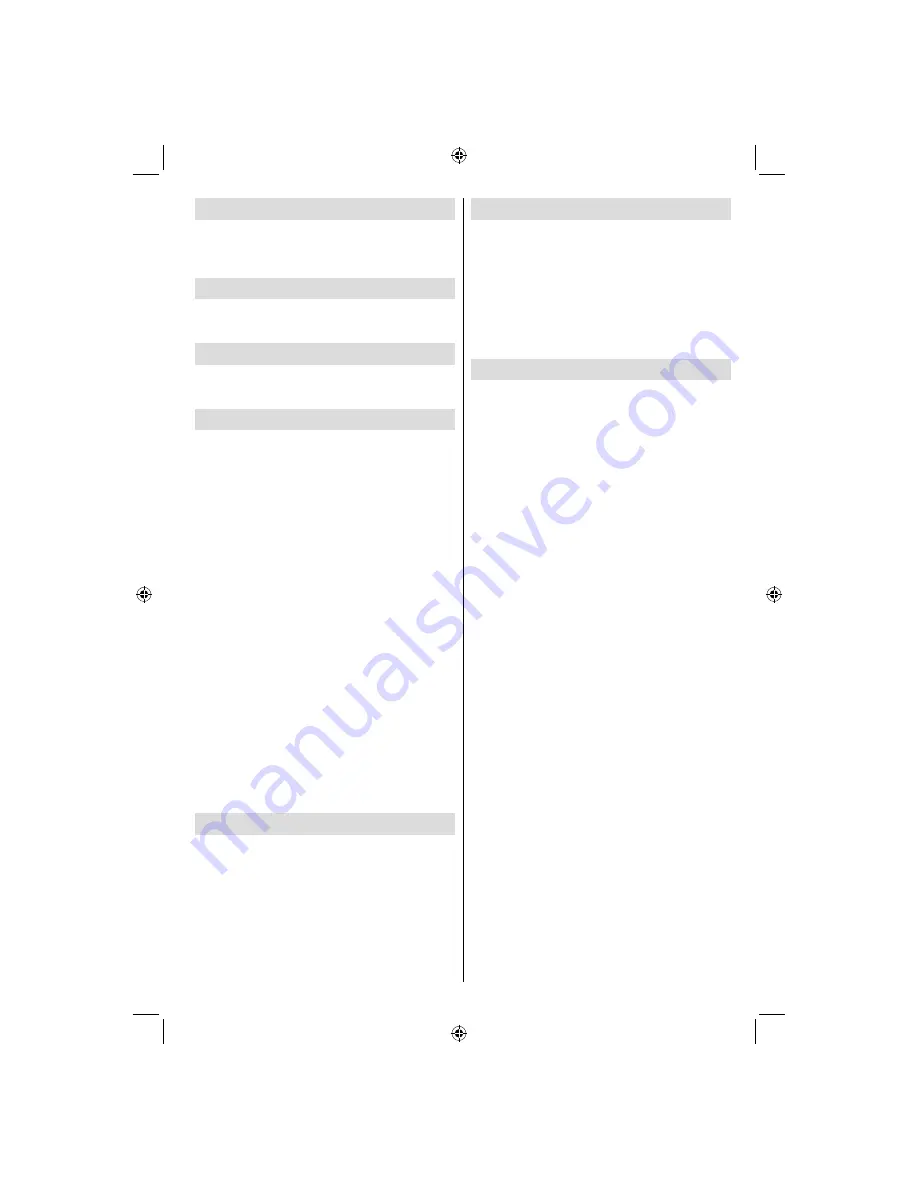
English
- 9 -
Menu Operation
Press MENU button on your remote control to display main menu
screen. Use Left or Right button to select a menu tab and press
OK to enter. Use Left / Right / Up / Down to select or set an item.
Press RETURN/BACK or MENU button to quit a menu screen.
Input Selection
Once you have connected external systems to your TV, you can
switch to different input sources. Press
SOURCE
button on your
remote control consecutively to select the different sources.
Changing Channels and Volume
You can change the channel and adjust the volume by using the
V+/-
and
P+/-
buttons on the remote. You can also change the
channels by pressing the buttons on the front panel of your TV.
Media Playback via USB Input
You can connect a USB hard disk drive or USB memory stick to
your TV by using the USB inputs of the TV. This feature allows
you to play
fi
les stored in a USB drive. 2.5” and 3.5” inch (hdd with
external power supply) external hard disk drives are supported.
IMPORTANT !
You should back up your
fi
les before making any
connections to the TV set in order to avoid any possible data loss.
Note that manufacturer will not be responsible for any
fi
le damage
or data loss. It is possible that certain types of USB devices (e.g.
MP3 Players) or USB hard disk drives/memory sticks may not be
compatible with this TV. The TV supports FAT32 and NTFS disk
formatting.
Note: While formatting a USB hard disk that has 1TB
(Tera Byte) or more
fi
le capacity, you can experience problems
with the formatting process. Quickly plugging and unplugging
USB devices, is a very hazardous operation. Especially, do not
repeatedly quickly plug and unplug the drive. This may cause
physical damage to the USB player and especially the USB device
itself. Do not pull out USB module while playing a
fi
le.
Media Browser Menu
You can play photo, music, and movie
fi
les stored on a USB disk
by connecting it to your TV and using the Media Browser screen.
To do this, perform the following: Connect a USB disk to the
USB input located on the side of the TV. Press
MENU
button and
select Media Browser tab by using
Left/Right
and
OK
buttons.
Main media browser screen will be displayed. You can display
the related content by selecting the Video, Music or Picture tab.
Follow the button indications under each on screen menu for
media playback features.
Changing Image Size: Picture Formats
Programmes can be watched in different picture formats, depending
on the transmission received. You can change the aspect ratio (image
size) of the TV for viewing the picture in different zoom modes. Press
SCREEN
button repeatedly to change the image size.
Using the Channel List
The TV sorts all stored stations in the Channel List. You can edit
this channel list, set favourites or set active stations to be listed by
using the Channel List options. Press
MENU
button to view main
menu. Select Channel List item by using
Left
or
Right
button.
Press
OK
to view menu contents. Select
Edit Channel List
to
manage all stored channels. Use
Up
or
Down
and
OK
buttons
to select
Edit Channel List
. Press
Up
or
Down
button to select
the channel that will be processed. Press
Left
or
Right
button
to select a function on Channel List menu. Use
P+/P-
buttons to
move page up or down. Press
MENU
button to exit.
De
fi
nition of important terms - TV
Aspect Ratio
This refers to the ratio of the width to the height of a picture.
AVL
Automatic volume limiter.
Brightness
This de
fi
nes the overall light level of the entire image.
Contrast
This will adjust the range of optical density and tone of the
complete picture.
Component Audio Inputs
Used for the standard analog audio for interconnection of
components.
Component Video Inputs (Y/Pb/Pr)
This video signal consist of colour differences and a luminance
signal.
DTV
Digital television broadcasts.
HDMI
High De
fi
nition Multimedia Interface. This connection provides
high-quality, uncompressed digital video and audio, combining
both audio and video signals via a single connection.
Multichannel audio
Means that the TV program is aired in several audio versions,
for example, in two different languages. This is possible if on
an analogue TV each of the two channels of the stereo tracks
for left and right channels are occupied with one audio track in
mono (single channel).In digital TV multiple audio streams can be
broadcasted and selected on the receiver side
NTSC
United States’ standard for scanning television signals that has
been adopted by some other countries.
LCN
LCN is the Logical Channel Number system that organizes
available broadcasts in accordance with a recognizable channel
sequence.
OSD
On Screen Display. Information, like channel number and volume
on the screen of a TV.
01_MB6X_[GB]_HITACHI_ORTAK_IB_50214635.indd 9
01_MB6X_[GB]_HITACHI_ORTAK_IB_50214635.indd 9
10.02.2012 17:52:48
10.02.2012 17:52:48











































